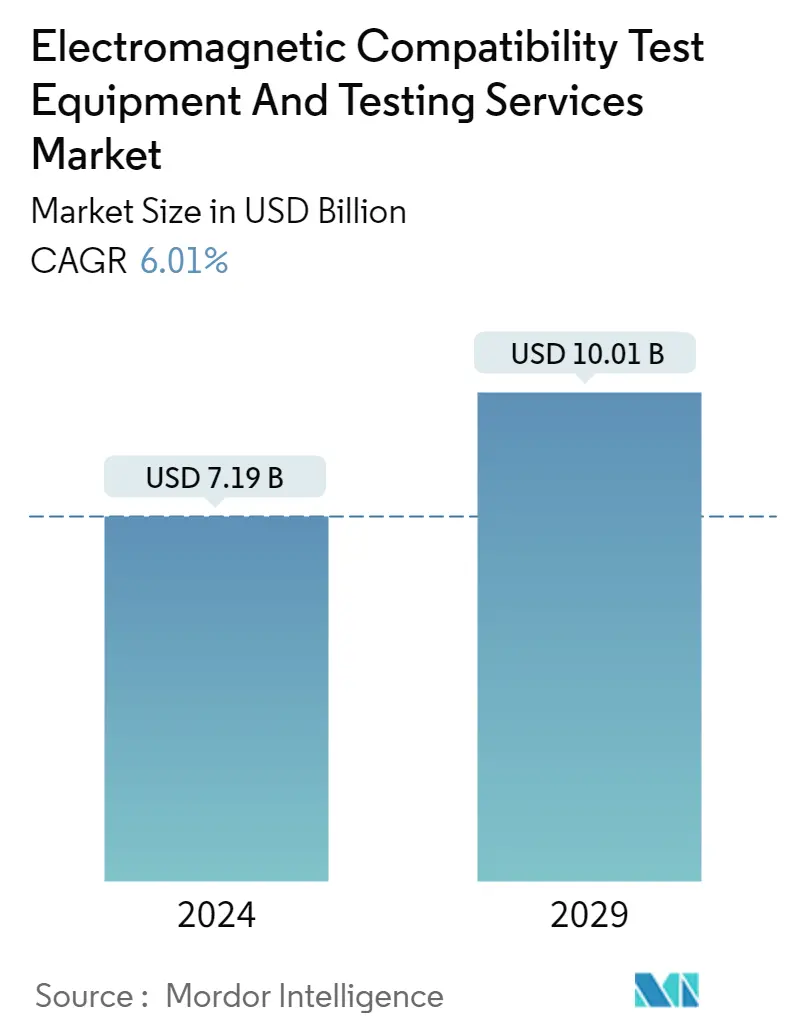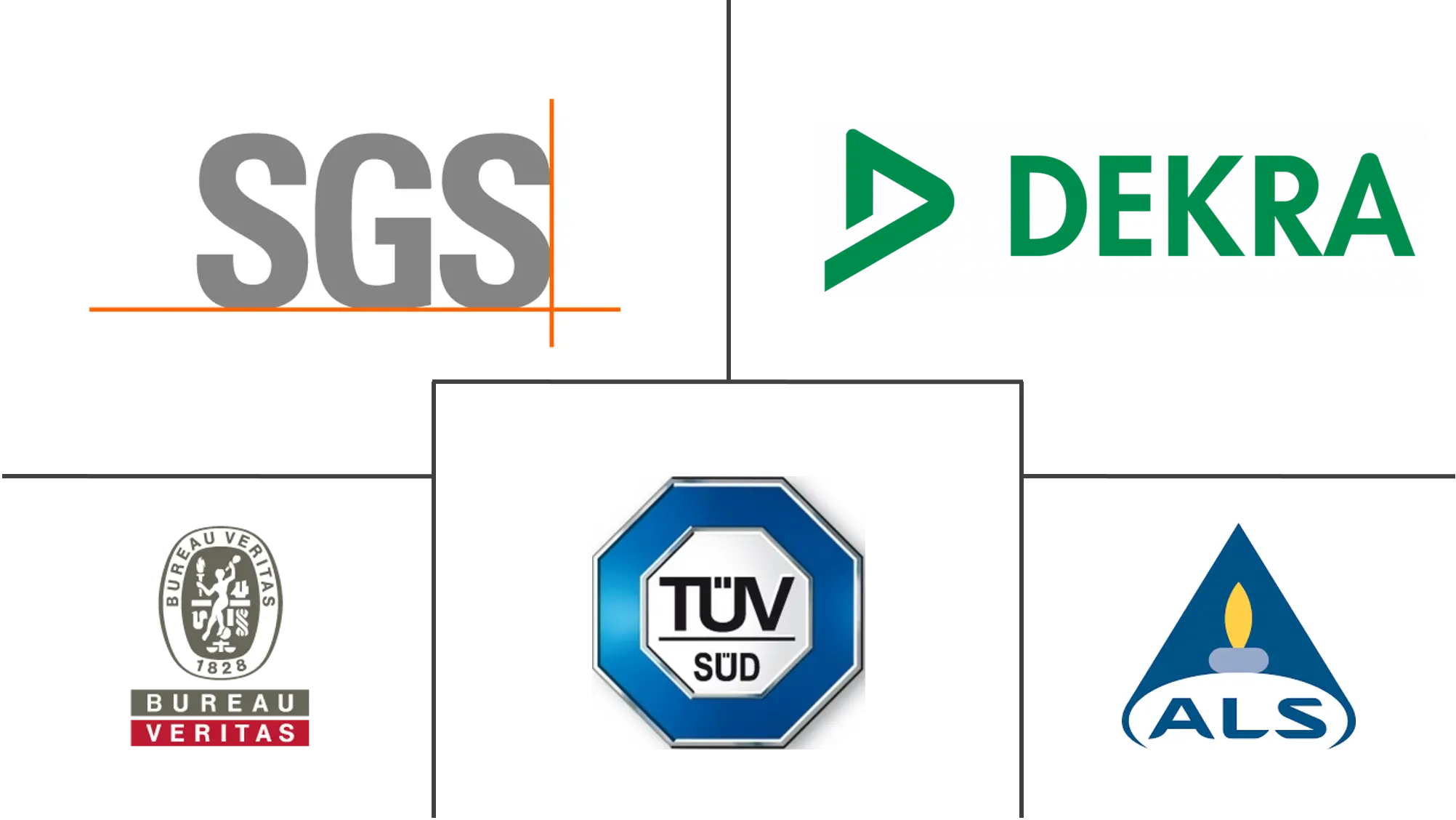Market Size of Electromagnetic Compatibility Test Equipment And Testing Services Industry

| Study Period | 2019 - 2029 |
| Market Size (2024) | USD 7.19 Billion |
| Market Size (2029) | USD 10.01 Billion |
| CAGR (2024 - 2029) | 6.01 % |
| Fastest Growing Market | Asia Pacific |
| Largest Market | North America |
Major Players
*Disclaimer: Major Players sorted in no particular order |
Electromagnetic Compatibility Test Equipment Market Analysis
The Electromagnetic Compatibility Test Equipment And Testing Services Market size is estimated at USD 7.19 billion in 2024, and is expected to reach USD 10.01 billion by 2029, growing at a CAGR of 6.01% during the forecast period (2024-2029).
- The increasing usage of electronic devices across various end-user industries makes electromagnetic compatibility (EMC) an essential service, as it helps minimize the possibility that radiated or conducted emissions produced by a device interfere with other electronic products in its vicinity.
- Electromagnetic Compatibility testing equipment and services analyze the ability of electronic devices to operate as anticipated in their electromagnetic environment when in proximity to other electronic devices or in the presence of electromagnetic disturbances that can interfere with their intended operation.
- Hence, electromagnetic compatibility (EMC) testing is a crucial step in electronic device design and manufacturing processes. Various regulatory bodies, including the FCC, FDA, and ISO, have set specific limits/frameworks on the emissions that can be released from an electronic device. These regulations provide improved safety and reliability for anyone using electrical/electronic equipment by assuring the device does not interfere with other equipment or fail to operate as intended.
- To comply with market requirements and avoid costly recalls, manufacturers in industries such as consumer products, medical devices, industrial machinery, railway, automotive, aerospace, and military equipment must ensure that electromagnetic disturbances do not interfere with the function of their products. These manufacturers are also under pressure to maintain quality while reducing costs and time to market owing to the growing presence of related regulatory frameworks.
- Growth in the world's population and economy and rapid urbanization are expected to increase energy demand over the coming years. The United Nations (UN) estimates that the world's population will grow from 7.6 billion in 2017 to 9.8 billion by 2050. This is anticipated to drive the number of electrical/electronic devices in use, thereby creating opportunities in the studied market.
- In recent years, the electrification trend has been gaining traction in the automotive industry. As electric vehicles incorporate many electronic components that emit radio-frequency/electromagnetic interference, they have the potential to negatively impact the vehicle's performance and driving experience. Hence, the electrification of vehicles leads to new EMC challenges because of higher switching frequencies of semiconductors and higher emissions due to high voltages and currents.
- Considering such trends, there are several vendors offering innovative solutions in the market. For instance, in November 2022, to ease and speed up the development process, AVL and Rohde & Schwarz, two of the prominent providers of automotive test systems, presented an innovative solution for automated electromagnetic compatibility data analysis of an electric drivetrain under real driving conditions.
- However, a higher price tag associated with electromagnetic compatibility test equipment and services is among the major factors challenging the studied market's growth. Furthermore, a higher average time period of EMC testing is also among the key restraining factors for the studied market's growth.
Electromagnetic Compatibility Test Equipment Industry Segmentation
Electromagnetic compatibility (EMC) testing measures an electrical product’s ability to function satisfactorily in its intended electromagnetic environment without generating intolerable electromagnetic disturbances to anything in that environment.
The electromagnetic compatibility test equipment and testing services market is segmented by type (test equipment and services), end-user industry (automotive, consumer electronics, it and telecom, aerospace and defense, healthcare, and other end-user industries), and geography (North America, Latin America, Europe, Asia-Pacific, and Middle East and Africa).
The market sizes and forecasts are provided in terms of value (USD) for all the above segments.
| By Type | |||||||
| |||||||
| Services |
| By End-user Industry | |
| Automotive | |
| Consumer Electronics | |
| IT and Telecom | |
| Aerospace and Defense | |
| Healthcare | |
| Other End-user Industries |
| By Geography*** | |
| North America | |
| Europe | |
| Asia | |
| Australia and New Zealand | |
| Latin America | |
| Middle East and Africa |
Electromagnetic Compatibility Test Equipment And Testing Services Market Size Summary
The electromagnetic compatibility (EMC) test equipment market is poised for significant growth, driven by the increasing integration of electronic devices across various industries. As electronic devices become more prevalent, ensuring they operate without interfering with each other is crucial. This necessity is underscored by regulatory bodies like the FCC, FDA, and ISO, which impose strict emission limits to enhance safety and reliability. Industries such as consumer electronics, automotive, aerospace, and healthcare are particularly impacted, as they must navigate complex regulatory landscapes while maintaining product quality and reducing time to market. The rise of electrification in the automotive sector, with electric vehicles incorporating numerous electronic components, presents new EMC challenges, further fueling the demand for advanced testing solutions.
North America stands out as a key region for EMC testing, supported by robust infrastructure, favorable policies, and a strong consumer electronics industry. The United States, in particular, benefits from stringent regulations and a thriving automotive sector, which necessitates comprehensive EMC testing to ensure the seamless operation of electronic systems in vehicles. The presence of numerous testing service providers in North America bolsters market growth, as they offer innovative solutions to meet evolving industry demands. Globally, the market is characterized by strategic partnerships and technological advancements, with companies like Emitech and SGS expanding their testing capabilities to cater to diverse sectors, including automotive, industrial, and consumer electronics. These developments highlight the critical role of EMC testing in ensuring product compliance and performance in an increasingly interconnected world.
Electromagnetic Compatibility Test Equipment And Testing Services Market Size - Table of Contents
-
1. MARKET INSIGHTS
-
1.1 Market Overview
-
1.2 Industry Attractiveness - Porter's Five Force Analysis
-
1.2.1 Threat of New Entrants
-
1.2.2 Bargaining Power of Buyers/Consumers
-
1.2.3 Bargaining Power of Suppliers
-
1.2.4 Threat of Substitute Products
-
1.2.5 Intensity of Competitive Rivalry
-
-
1.3 Assessment of impact of Macro Trends on the Industry
-
-
2. MARKET SEGMENTATION
-
2.1 By Type
-
2.1.1 Test Equipment
-
2.1.1.1 EMI Test Receiver
-
2.1.1.2 Signal Generator
-
2.1.1.3 Amplifiers
-
2.1.1.4 Spectrum Analyzer
-
2.1.1.5 Other Test Equipments
-
-
2.1.2 Services
-
-
2.2 By End-user Industry
-
2.2.1 Automotive
-
2.2.2 Consumer Electronics
-
2.2.3 IT and Telecom
-
2.2.4 Aerospace and Defense
-
2.2.5 Healthcare
-
2.2.6 Other End-user Industries
-
-
2.3 By Geography***
-
2.3.1 North America
-
2.3.2 Europe
-
2.3.3 Asia
-
2.3.4 Australia and New Zealand
-
2.3.5 Latin America
-
2.3.6 Middle East and Africa
-
-
Electromagnetic Compatibility Test Equipment And Testing Services Market Size FAQs
How big is the Electromagnetic Compatibility Test Equipment And Testing Services Market?
The Electromagnetic Compatibility Test Equipment And Testing Services Market size is expected to reach USD 7.19 billion in 2024 and grow at a CAGR of 6.01% to reach USD 10.01 billion by 2029.
What is the current Electromagnetic Compatibility Test Equipment And Testing Services Market size?
In 2024, the Electromagnetic Compatibility Test Equipment And Testing Services Market size is expected to reach USD 7.19 billion.

